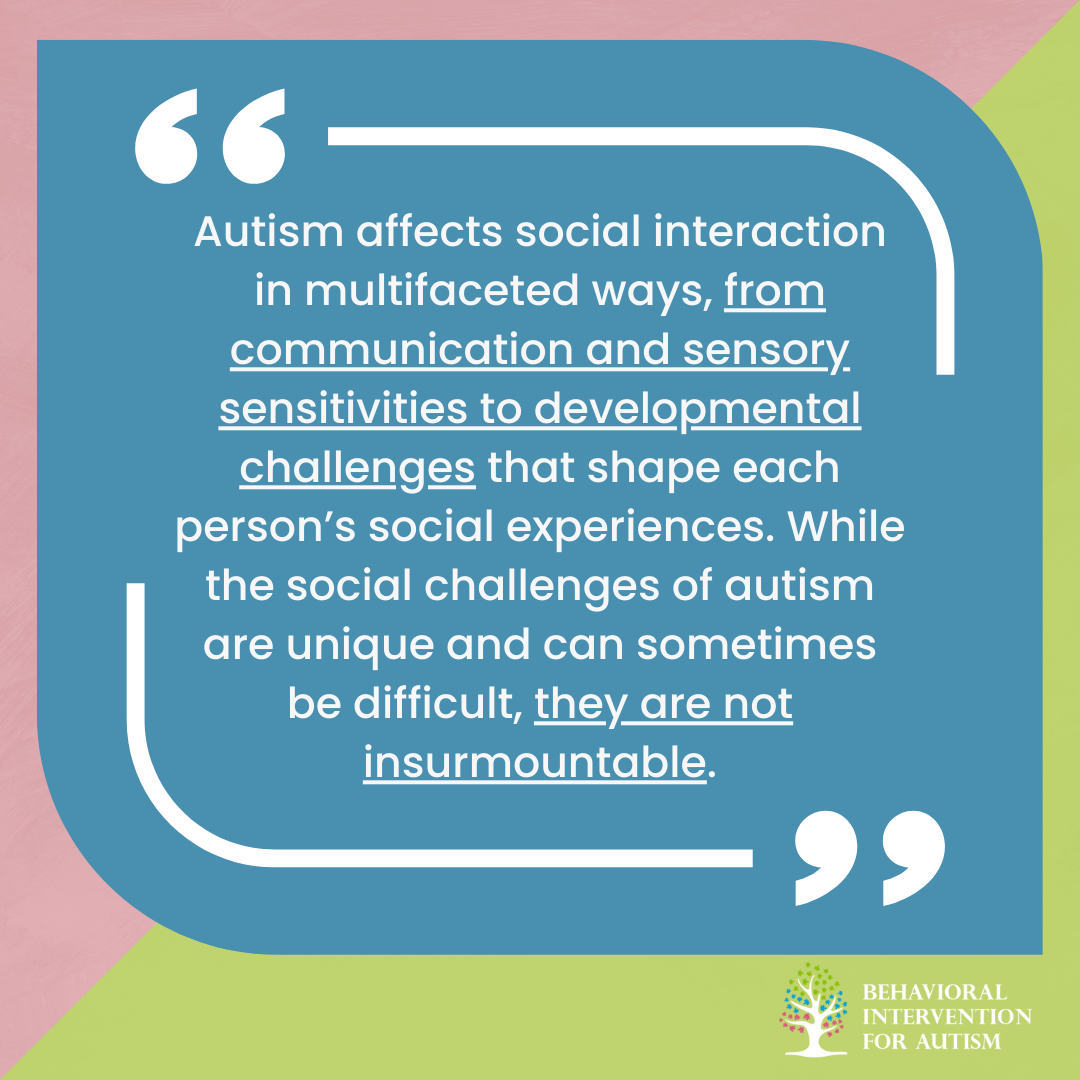
Table of Contents
Social interaction is a fundamental part of human life, helping us to connect, build relationships, and navigate the world. For individuals with autism spectrum disorder (ASD), however, social interactions often present unique challenges that can impact their ability to communicate, interpret social cues, and engage meaningfully with others. These challenges vary in type and intensity across the autism spectrum, making the social experience of each person with autism truly unique. Understanding how autism affects social interaction provides a foundation for fostering connection and empathy and offers insights into effective support strategies.
This article delves into the many ways autism affects social interactions, exploring communication differences, interpreting social cues, sensory sensitivities, and the developmental aspects that influence social behavior in people with ASD. We’ll also look at practical support and intervention approaches that can help individuals with autism build their social skills and develop more positive, comfortable interactions.
Understanding Autism Spectrum Disorder (ASD)
Autism spectrum disorder is a developmental condition characterized by challenges in social communication, repetitive behaviors, and specific interests. The term “spectrum” signifies that autism manifests differently in each individual, with variations in strengths and challenges. Some people with autism may have strong language skills and enjoy engaging in certain types of social interactions, while others may be nonverbal and find even brief social exchanges overwhelming.
ASD is commonly diagnosed in early childhood and often includes developmental differences that impact social communication and understanding. The Centers for Disease Control and Prevention (CDC) estimates that approximately 1 in 36 children in the United States is diagnosed with autism, and while the prevalence varies globally, autism is a universally recognized condition that influences social interactions across all cultures.
Core Features of Social Challenges in Autism
Several core features typically characterize social challenges in autism, including:
- Difficulty with social-emotional reciprocity: This involves the ability to engage in a back-and-forth conversation, share interests or emotions, and respond to others’ feelings.
- Difficulty in understanding nonverbal cues: Interpreting facial expressions, body language, and tone of voice can be challenging, making it harder for individuals to accurately assess social situations.
- Developing and maintaining relationships: Forming friendships and other relationships can be complex, as individuals with autism may struggle with understanding social norms or may find social interactions overwhelming.
Each of these elements contributes to the broader social interaction challenges often experienced by those on the autism spectrum.

Social Communication Challenges in Autism
One of the most commonly affected areas of social interaction in autism is communication. Communication challenges can include both verbal and nonverbal aspects, impacting how individuals initiate and maintain interactions. The difficulties associated with social communication can vary widely among individuals with ASD.
Verbal Communication Challenges
For individuals with autism, verbal communication can sometimes be limited or atypical in various ways:
- Delayed language development: Some children with autism experience delayed language skills, which can make it difficult to participate in early childhood social interactions.
- Literal interpretation: Many people with autism interpret language literally, which can lead to misunderstandings in situations involving sarcasm, humor, or figures of speech.
- Unusual speech patterns: Some individuals with autism may have unique ways of speaking, such as using a monotone voice, echoing phrases (echolalia), or focusing on specific topics with great intensity.
Nonverbal Communication Challenges
Nonverbal communication is a significant part of human interaction and involves elements like facial expressions, body language, and eye contact. For individuals with autism:
- Eye contact can be uncomfortable and may be avoided, as some individuals find it overstimulating or distracting.
- Understanding body language and facial expressions may be challenging, leading to difficulties in recognizing emotions or intentions in others.
- Tone of voice interpretation can be complicated, making it hard for individuals with autism to gauge when someone is joking, excited, or upset.
Difficulty with Social Reciprocity
Social reciprocity refers to the natural flow of give-and-take in social interactions. For those with autism, this can be a challenging aspect of social communication, as it may be difficult to:
- Initiate conversations or activities with others due to discomfort or uncertainty about how to start an interaction.
- Respond to others’ emotions or maintain interest in others’ topics, especially if these topics do not align with the individual’s own interests.
- Take turns in conversations and allow for shared interactions, as some may find it easier to talk about a personal interest in a monologue format.
Repetitive and Restricted Interests and Their Impact on Social Interaction
Repetitive behaviors and intense interests are common in autism, and while these can be a source of joy and satisfaction, they may also impact social interactions:
- Restricted interests can lead to challenges in finding common topics with peers, as individuals with autism may prefer to talk about a particular subject with great depth rather than exploring new topics.
- Repetitive behaviors such as hand-flapping, rocking, or repeating phrases may make it challenging for others to engage comfortably, sometimes leading to misunderstandings or discomfort in social settings.

Sensory Sensitivities and Their Role in Social Interaction
People with autism often experience heightened or decreased sensitivity to sensory stimuli, which can significantly affect their social interactions. Common sensory sensitivities include responses to sounds, lights, textures, or smells, and these sensory differences can create obstacles in social settings.
Overstimulation in Social Environments
Crowded or noisy places can be overwhelming for individuals with autism due to heightened sensitivity to sensory inputs. Environments like schools, malls, or family gatherings may cause:
- Anxiety or sensory overload, making it challenging to participate fully in social events.
- Avoidance of specific social settings due to discomfort or stress caused by noise, lighting, or other sensory elements.
- Difficulties in focusing on conversations or interactions when the sensory environment is distracting.
Sensory-Seeking Behaviors and Social Reactions
On the other hand, some individuals with autism exhibit sensory-seeking behaviors, where they actively seek out sensory input:
- Touching objects or people frequently as a means of sensory input, which may be misinterpreted by others.
- Making loud sounds or engaging in other sensory-stimulating activities that can sometimes disrupt social interactions.
By understanding and accommodating sensory needs, social interactions can be improved for individuals with autism.

Developmental Aspects Affecting Social Skills in Autism
Autism affects social development differently based on age, individual characteristics, and support systems. Social challenges can change over time, and with the right strategies and support, many individuals with autism can build and strengthen social skills.
Early Childhood
For many children with autism, social difficulties appear early in life. Young children with autism may:
- Show less interest in social games such as peek-a-boo or other activities that encourage shared attention.
- Struggle with pretend play, which is often a key part of social development in early childhood.
- Have difficulty responding to social cues from peers, such as smiling or making eye contact.
School-Age Children
As children grow, social expectations increase, and for children with autism, this can bring new challenges. In school settings, they may:
- Struggle with group activities or teamwork, where reading social cues is essential.
- Experience challenges with friendships, as they may find it hard to understand the dynamics of peer relationships.
- Encounter bullying or social exclusion, as peers may not fully understand or accept their differences.
Adolescence and Adulthood
Social challenges often persist into adolescence and adulthood for individuals with autism, though these can take on new forms:
- Romantic relationships and friendships may be complicated, as interpreting the nuanced emotions involved can be challenging.
- Workplace social interactions may pose challenges, with misunderstandings sometimes arising due to communication styles.
- Independence in social settings can be difficult, especially for individuals who may rely on family or caregivers to help navigate complex social dynamics.
Supporting Social Skills Development in Autism
While social challenges are a key part of autism, there are many ways to support individuals in building social skills and navigating interactions more comfortably.
1. Structured Social Skills Training
Structured social skills programs can be effective in helping individuals with autism learn specific social skills:
- Role-playing and modeling provide concrete examples of appropriate social behavior.
- Social stories are used to help individuals understand social norms and expectations in specific situations.
- Practical exercises such as conversation starters and turn-taking activities can make social skills more accessible and relatable.
2. Peer-Mediated Interventions
Peer-mediated approaches involve engaging neurotypical peers to facilitate social interactions. For instance:
- Peer buddies in school settings can help students with autism feel more included and supported.
- Group activities that emphasize collaboration can encourage individuals with autism to practice social skills in a structured environment.
3. Sensory Accommodations
Creating sensory-friendly environments can greatly support social interaction for individuals with autism. This might include:
- Reducing noise levels in social spaces or allowing individuals to wear noise-canceling headphones.
- Providing sensory tools such as fidget toys or weighted blankets that can help reduce anxiety in social settings.
4. Supportive Technology
Technology can also play a helpful role in developing social skills:
- Apps that teach social cues can provide interactive opportunities to practice understanding emotions and body language.
- Video modeling offers a visual method for learning social behaviors, where individuals watch videos demonstrating social interactions.

With understanding, patience, and tailored support, individuals with autism can navigate social interactions successfully, forming connections and enriching their social lives. Families, friends, educators, and communities all play a vital role in creating inclusive environments where people with autism feel empowered to engage and connect.
Autism may change how someone interacts socially, but it does not diminish their capacity for meaningful relationships and fulfilling interactions. By fostering an environment of empathy, awareness, and support, we can help bridge the social gap, enabling individuals with autism to thrive in their interactions and to feel valued for the unique perspectives they bring to the world.
Take the Next Step Towards Support
Autism can significantly impact social interaction, making it challenging for individuals to navigate conversations, understand social cues, and form relationships. This difficulty can lead to feelings of isolation and frustration, both for those on the spectrum and their families. By engaging in targeted interventions, such as ABA therapy in Florida, individuals can develop essential social skills and improve their ability to connect with others.
Behavioral Intervention For Autism is committed to providing high-quality, personalized therapy that focuses on enhancing social interaction and communication skills. Our compassionate team works closely with each individual to create a supportive environment tailored to their needs. If you’re looking to empower yourself or a loved one, reach out to us today to explore how we can help!
- 9 Common Obsessions of Children With Autism You Should Know - February 25, 2025
- What is Neurodiversity? A Guide to Embracing Differences - February 25, 2025
- Understanding Hyperfocus in Autism: What It Means and Why It Happens - February 25, 2025
